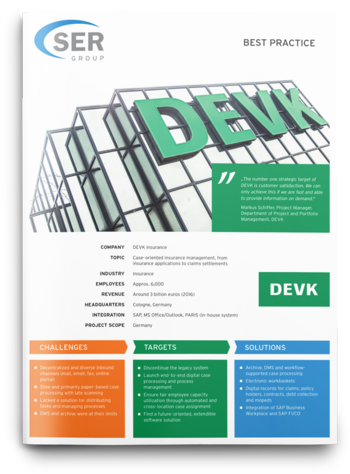SER Blog Customer Stories & Use Cases
InsurTech: Competitor or partner?
InsurTechs are going digital with insurance services and reimagining processes in the insurance industry – for both insurance companies and their customers. In the process, InsurTechs are also spurring the inevitable transition from traditional to digital value chains in the insurance market.
The industry sees InsurTechs as both an opportunity and a threat. What they are ultimately depends on whether insurance companies evolve and welcome InsurTechs as partners or perceive them as competitors.
In this article, we look at InsurTech companies. What are InsurTechs? How are they transforming the insurance industry? And how can insurance providers work with InsurTechs to optimize and redesign their processes?

What is an InsurTech company?
InsurTech is short for “insurance technology,” these companies provide insurance services based on digital technology.
Since the InsurTech market is relatively new, the companies in this sector are currently mostly start-ups. In Germany, 128 InsurTech start-ups were founded in the last ten years as of 2023 – and there are over 100,000 InsurTechs across Europe. They differ as B2C and B2B companies, and operate either as full-service insurers or as brokers.
Is competition growing in the insurance industry?
As full-service insurers, InsurTechs compete directly with traditional insurance companies. However, in order to position themselves in established market segments, they often lack market and insurance knowledge, patience in developing processes, trust and, last but not least, investors.
For this reason, InsurTechs are moving increasingly into niches and occupying sub-areas within the segment. One such segment is embedded insurance, which refers to insurance that is integrated already in a service or product purchased by a consumer. The study “Europe Embedded Insurance Business and Investment Opportunities” projects annual growth of 19.4 percent in this niche until 2029.
This reflects the trend that policy holders do not want to bother with their insurance. This is exactly how InsurTechs are supporting insurance companies in the B2B sector.

DEVK: Process-centric insurance management
Read all about how DEVK uses Doxis for digital application processing and claims settlement — across locations and divisions
Read nowCompetitors become partners
When full-service insurers forge partnerships with InsurTechs, they expand their portfolio and add small sub-areas to their comprehensive solution.
For example, they develop new processes or procedures so that policy holders and the insurance company itself can capture and process claims digitally. InsurTechs also rely on innovative services to manage policies, minimize risks using predictive analytics, or create customized quotes with flexible prices.
When full-service insurers see InsurTech companies as partners rather than competitors in the future, they will be able to integrate their offerings in their own insurance networks and generate added value. The new services mean that insurance companies can meet customer needs and requirements much more effectively – which is a win-win situation.
So how can InsurTechs help you to develop your traditional business?
No partnership without digitalization
In order to forge partnerships with InsurTech companies, insurance companies have to adapt to the new players on the market. From the start, InsurTechs position themselves as digital insurers. They are very modern both internally and in relation to customers. As a result, traditional companies need to first have a certain level of digital maturity and establish connections before they can do business with InsurTechs. Your insurance company will therefore need a digitalization strategy by then at the latest.
From on-premise to the cloud
It is not enough to digitize traditional processes and implement these locally. In this approach, you only digitize internal processes, not those with other stakeholders such as policy holders or partners.
A central principle of your digitalization strategy has to be setting up internal and external processes in the cloud. Cloud solutions simplify the exchange, enable access to documents from anywhere and at any time, and enable users to work in parallel. They are also the basis for additional services such as smartphone apps for customers or process automation through AI.
Unimpeded access to information
Digital insurance processes also centralize the flow of information. All documents and data are stored in digital files in an enterprise content management system (ECM). This can help you to avoid dark data – or data that exists but cannot be used. With an ECM system, you can extract relevant information, structure it, and store it in context in the proper digital file. Insurance contracts, for example, can be found at any time in a corresponding folder in the digital customer eFile.
Both employees and customers can quickly access the information they need. At the same time, central and automated document management can provide insurance companies with further opportunities: using data analysis, they can develop insurance products based on data or identify risks early.
Easy connection options
Analytics and other benefits are improved when systems such as an ECM communicate with other systems. In this way, you can create an ecosystem without media disruption. State-of-the-art ECM software already provides many integration options and can also be connected easily to other systems, as necessary. This is exactly what is needed to work with InsurTechs.
However, this is comparatively difficult with legacy systems, where integration options for third-party systems are very limited and extremely complex.

Helvetia Versicherungen: Digital transformation with ECM
Read all about how insurance provider Helvetia is pursuing its company-wide digitalization strategy with the Doxis ECM platform as its basis.
Read nowInnovative and future-proof systems
Legacy systems are not future-proof. When you rely on legacy systems, you also miss out on innovations – such as the use of artificial intelligence (AI). AI now simplifies and optimizes numerous processes. On a small scale, the use of AI makes daily routine tasks such as those of an administrator easier. Thinking big, AI can process big data and optimize all the related processes.
Currently, AI is the technology that everyone is talking about. In the future, it will probably be something else. But one thing is clear: legacy systems don’t help you keep up with the times. Your goal, in contrast, should be to make your IT landscape future-proof. To do so, it has to be scalable and provide room for innovation.
Doxis Intelligent Content Automation for insurers
Doxis is your future-proof ECM system With ICA, Intelligent Content Automation, Doxis is setting new benchmarks for today and tomorrow. It relies on cloud-native solutions, manages content, and automates content processes across systems, integrates seamlessly in a variety of business applications, and puts information in context via content understanding. This ensures that you meet all the requirements for your insurance company to work successfully with InsurTechs.
Practical example: Managing insurance documents with Doxis
With Doxis, processes virtually run themselves. The following example shows how you can manage documents in Doxis after conclusion of a contract.
Hey Doxi, how can I efficiently manage insurance documents in Doxis?
Adding a new contract partner
-
Adding a new contract partner: Doxis automatically creates a digital file when you add a new insurance partner in your primary system.
-
Structuring a contract eFile: Doxis places all the necessary folders as well as dividers in the digital eFile according to the standardized filing structure.
-
Filing contract data in context: Doxis links the contract partner with all of their contracts.
-
Creating an insurance contract: Doxis creates the insurance contract including contract number for you. One click takes you from contract partner to contract data.
-
Displaying business partners: Doxis shows on the cover sheet who is the policy holder and who is the insured, and provides links to the insurance broker.
Viewing broker data
-
Viewing broker data: Doxis displays the data for insurance brokers in an easy-to-read cover sheet.
-
Viewing the file for an insurance broker: Doxis provides you with an overview of the policies sold by the insurance broker.
Managing claims
-
Reporting claims: In Doxis, you create a claim eFile when you file a damage report. To do this, you call up the contract eFile for the contract partner and validate that the damage is insured.
-
Documenting a claim: In the claim eFile you store and archive all the information related to the claim.
-
Getting an overview of all claims: In Doxis, under “All Claims,” you can see the contract partner’s active and completed claims.
Manage customer processes even more efficiently with InsurTech partnerships
InsurTech as digital insurance technology is revolutionizing processes in the entire industry. InsurTech start-ups, in particular, are creating a new consumer understanding in the market and also new consumer expectations for insurance service providers. When InsurTech companies and insurance companies cooperate with each other, everyone benefits. Because this partnership expands and improves product portfolios, and in turn this has a positive impact on sales and customer relationship processes.
In order to take advantage of the opportunities provided by InsurTech, traditional companies first need to have a digitalization strategy. With Doxis Intelligent Content Automation, you can rely on future-proof processes and create the foundation for successful partnerships with InsurTechs and digital processes in general.
FAQs about InsurTech
The latest digitization trends, laws and guidelines, and helpful tips straight to your inbox: Subscribe to our newsletter.
How can we help you?
+49 (0) 30 498582-0Your message has reached us!
We appreciate your interest and will get back to you shortly.




